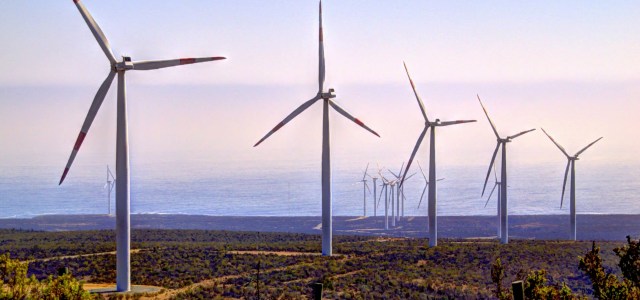When it comes to renewable energy development, Latin America is a mixed bag with a lot of potentials. Sandra Guzman provides an overview over what is holding the region back as well as its prospects.

Still an unusual sight in Latin America – windfarm in Chile. (Photo by Edu3k, CC BY-SA 3.0)
One of the key aspects increasing inequality in Latin America is the limited access to energy. According to the United Nations Industrial Development Organization, 40 million people in Latin America live without access to electricity. Paradoxically, there is no shortage of supply, which shows that the problem is predominately the distribution of energy.
An additional problem is that power generation is based overwhelmingly on fossil fuels, which implies high cost for non-oil producing countries in Latin America. In this sense, the region needs an alternative source of energy that, at the same time, can help to increase overall energy access.
In 2013, the Inter-American Development Bank (IADB) showed that Latin America has a great potential to develop renewable energy. According to their research, Latin America could produce enough electricity to cover 22 times the demand of the region by 2050. Furthermore, investments in renewable energy are increasing in Latin America but are still small; of the 224 billion dollar that were invested at the global level in 2012, only 5.4% was invested in the region.
The question is how the region will transit towards a low carbon development. If the region has huge potential in renewable energy, what is holding it back?
If we analyse each of the countries in the region, we can observe progress in some of them – for instance, in the creation of a Renewable Energy Law in Chile or the Renewable Energy and the Energy Transition Financing Law in Mexico. However, the levels of consumption show that countries are still highly dependent on fossil fuels. Three key reasons could explain this dependency: the fossil fuel subsidies that are still high in the region, particularly in Venezuela and Mexico; the carbon lock-in-thinking that still exists in many government and non-governmental institutions with little incentive to promote renewable energy; and the lack of investment in renewable energy on the whole, starting with public resources that could be complemented with international cooperation and private finance.
Although there is a thought that investment in renewable energy is more expensive, the IADB analysis points out that these technologies are in fact more attractive in financial terms. But in order to ensure a just competitive renewables scenario, it is important make a viable cost-benefit analysis on the social and environmental benefits of renewable energies on the one hand and the social and environmental costs of fossil fuels on the other.
In this sense, it is important to promote the energy transition towards renewable energy, including social and environmental safeguards. wind, solar, small hydro and geothermal systems have to include social and environmental safeguards as well. Otherwise, there will be a problem, such as the debate around large hydro dams. More than anything, it is vital to define what “clean” energy means, while ensuring that all “clean” technologies incorporate aspects of human rights and gender equity.
Sandra Leticia Guzman Luna holds a Masters Degree on Environmental Policy and Regulation from the London School of Economics and Political Science, she studied International Relations at the University of Mexico (UNAM), and is a specialist in Environmental and Energy Management from the Latin-American Social Science Institute (FLACSO).